System Thinking's Role in Addressing Sustainability Challenges
VerifiedAdded on 2020/03/04
|12
|3375
|31
Essay
AI Summary
This essay examines the critical role of system thinking in developing solutions to sustainability challenges. It begins by defining sustainability and its evolution in the 21st century, emphasizing the need for sustainable models to protect the environment and ensure the well-being of future generations. The essay highlights the importance of system thinking in addressing complex environmental, social, and economic issues. It discusses the application of system thinking in sustainable business practices, emphasizing the need for environmental preservation, social equity, and long-term profitability. The essay uses the example of Coal-Seam Gas extraction in Australia to illustrate the practical application of system thinking in diagnosing and addressing sustainability challenges, including the ethical dilemmas and environmental impacts. The analysis includes the three pillars of sustainability: economic, social, and environmental, and how system thinking can be applied in leadership and management to address issues such as system failures, confused goals, and inadequate feedback. The essay concludes by reinforcing the necessity of a holistic approach to tackle global sustainable development issues.
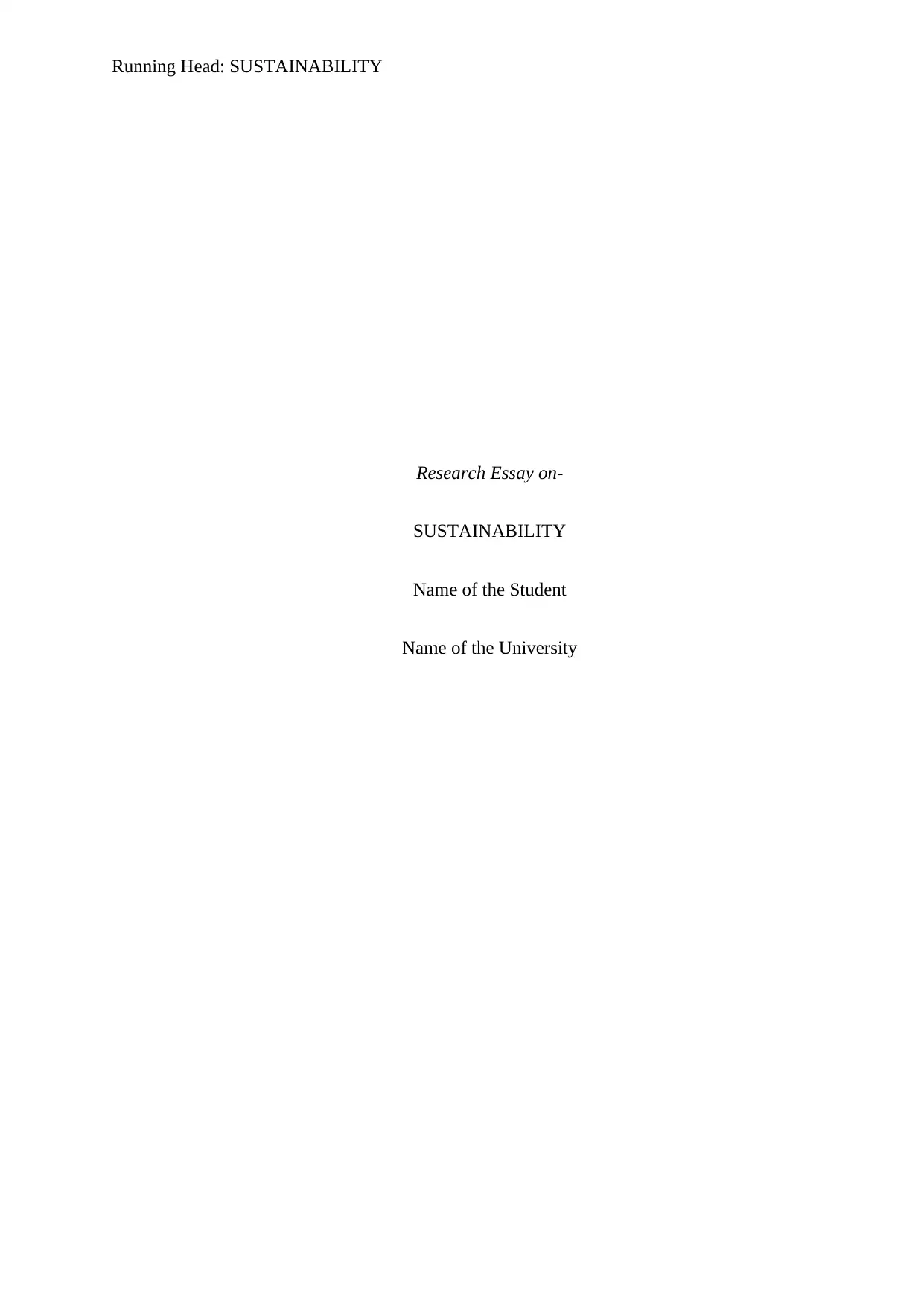
Running Head: SUSTAINABILITY
Research Essay on-
SUSTAINABILITY
Name of the Student
Name of the University
Research Essay on-
SUSTAINABILITY
Name of the Student
Name of the University
Secure Best Marks with AI Grader
Need help grading? Try our AI Grader for instant feedback on your assignments.
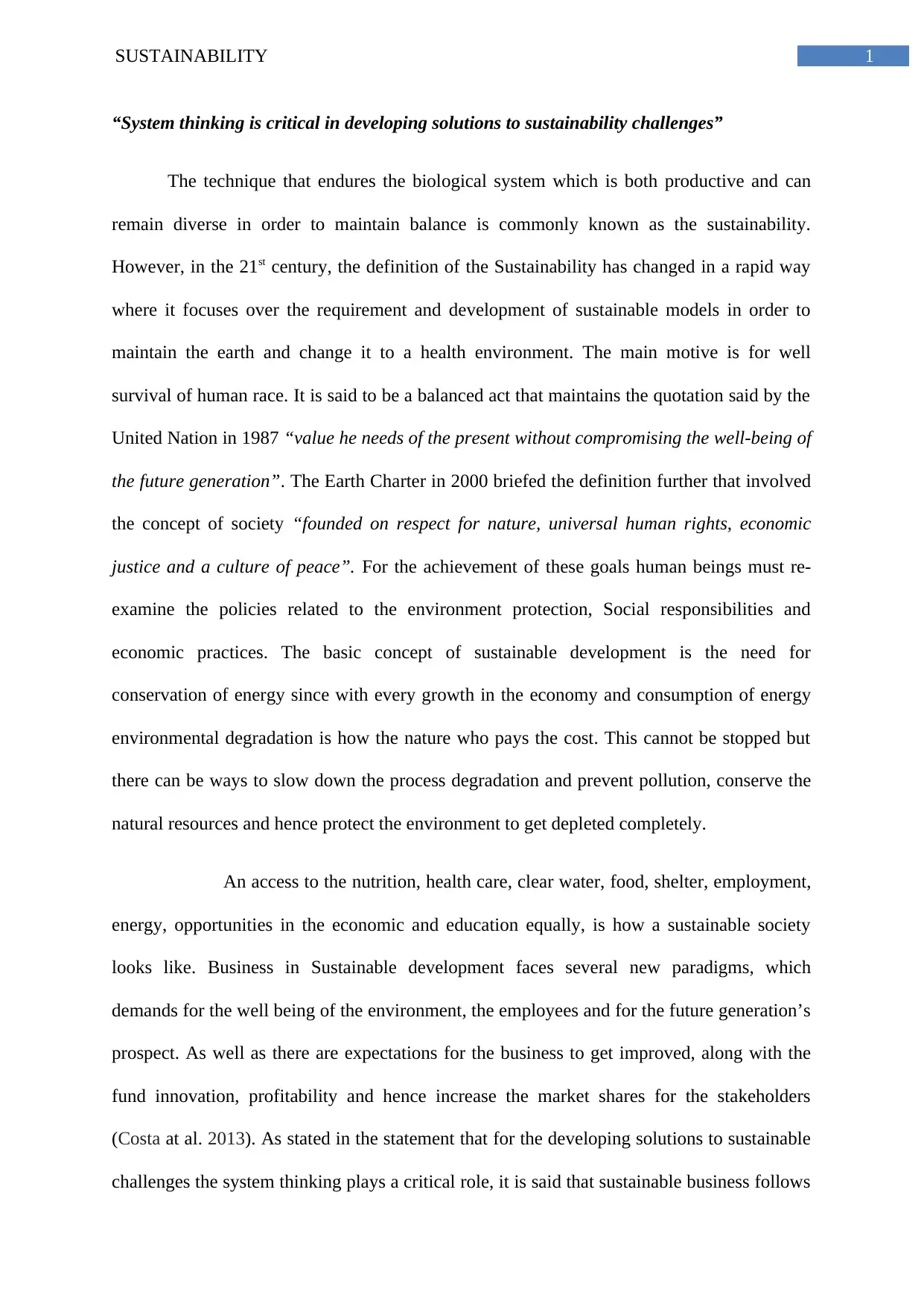
1SUSTAINABILITY
“System thinking is critical in developing solutions to sustainability challenges”
The technique that endures the biological system which is both productive and can
remain diverse in order to maintain balance is commonly known as the sustainability.
However, in the 21st century, the definition of the Sustainability has changed in a rapid way
where it focuses over the requirement and development of sustainable models in order to
maintain the earth and change it to a health environment. The main motive is for well
survival of human race. It is said to be a balanced act that maintains the quotation said by the
United Nation in 1987 “value he needs of the present without compromising the well-being of
the future generation”. The Earth Charter in 2000 briefed the definition further that involved
the concept of society “founded on respect for nature, universal human rights, economic
justice and a culture of peace”. For the achievement of these goals human beings must re-
examine the policies related to the environment protection, Social responsibilities and
economic practices. The basic concept of sustainable development is the need for
conservation of energy since with every growth in the economy and consumption of energy
environmental degradation is how the nature who pays the cost. This cannot be stopped but
there can be ways to slow down the process degradation and prevent pollution, conserve the
natural resources and hence protect the environment to get depleted completely.
An access to the nutrition, health care, clear water, food, shelter, employment,
energy, opportunities in the economic and education equally, is how a sustainable society
looks like. Business in Sustainable development faces several new paradigms, which
demands for the well being of the environment, the employees and for the future generation’s
prospect. As well as there are expectations for the business to get improved, along with the
fund innovation, profitability and hence increase the market shares for the stakeholders
(Costa at al. 2013). As stated in the statement that for the developing solutions to sustainable
challenges the system thinking plays a critical role, it is said that sustainable business follows
“System thinking is critical in developing solutions to sustainability challenges”
The technique that endures the biological system which is both productive and can
remain diverse in order to maintain balance is commonly known as the sustainability.
However, in the 21st century, the definition of the Sustainability has changed in a rapid way
where it focuses over the requirement and development of sustainable models in order to
maintain the earth and change it to a health environment. The main motive is for well
survival of human race. It is said to be a balanced act that maintains the quotation said by the
United Nation in 1987 “value he needs of the present without compromising the well-being of
the future generation”. The Earth Charter in 2000 briefed the definition further that involved
the concept of society “founded on respect for nature, universal human rights, economic
justice and a culture of peace”. For the achievement of these goals human beings must re-
examine the policies related to the environment protection, Social responsibilities and
economic practices. The basic concept of sustainable development is the need for
conservation of energy since with every growth in the economy and consumption of energy
environmental degradation is how the nature who pays the cost. This cannot be stopped but
there can be ways to slow down the process degradation and prevent pollution, conserve the
natural resources and hence protect the environment to get depleted completely.
An access to the nutrition, health care, clear water, food, shelter, employment,
energy, opportunities in the economic and education equally, is how a sustainable society
looks like. Business in Sustainable development faces several new paradigms, which
demands for the well being of the environment, the employees and for the future generation’s
prospect. As well as there are expectations for the business to get improved, along with the
fund innovation, profitability and hence increase the market shares for the stakeholders
(Costa at al. 2013). As stated in the statement that for the developing solutions to sustainable
challenges the system thinking plays a critical role, it is said that sustainable business follows
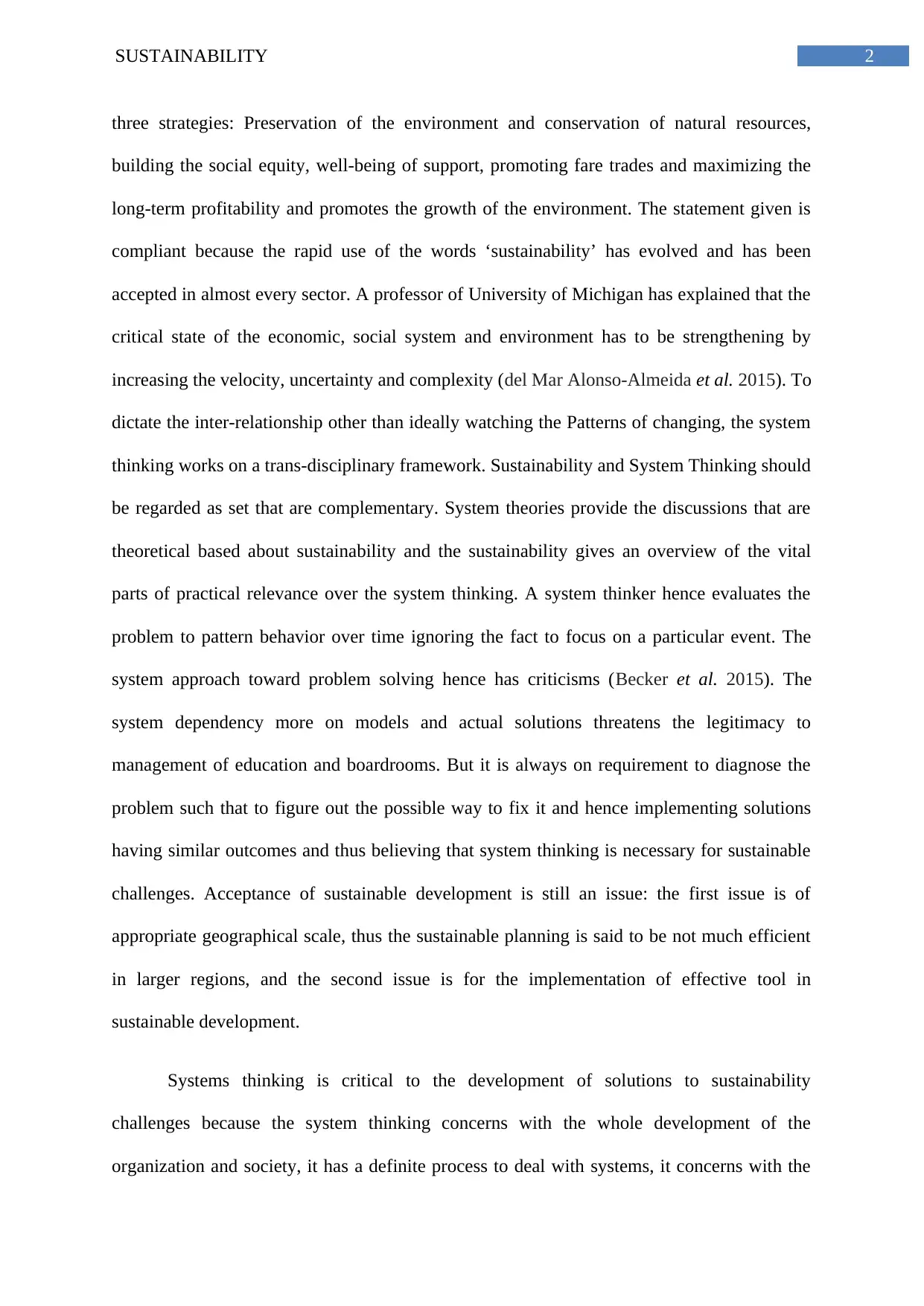
2SUSTAINABILITY
three strategies: Preservation of the environment and conservation of natural resources,
building the social equity, well-being of support, promoting fare trades and maximizing the
long-term profitability and promotes the growth of the environment. The statement given is
compliant because the rapid use of the words ‘sustainability’ has evolved and has been
accepted in almost every sector. A professor of University of Michigan has explained that the
critical state of the economic, social system and environment has to be strengthening by
increasing the velocity, uncertainty and complexity (del Mar Alonso-Almeida et al. 2015). To
dictate the inter-relationship other than ideally watching the Patterns of changing, the system
thinking works on a trans-disciplinary framework. Sustainability and System Thinking should
be regarded as set that are complementary. System theories provide the discussions that are
theoretical based about sustainability and the sustainability gives an overview of the vital
parts of practical relevance over the system thinking. A system thinker hence evaluates the
problem to pattern behavior over time ignoring the fact to focus on a particular event. The
system approach toward problem solving hence has criticisms (Becker et al. 2015). The
system dependency more on models and actual solutions threatens the legitimacy to
management of education and boardrooms. But it is always on requirement to diagnose the
problem such that to figure out the possible way to fix it and hence implementing solutions
having similar outcomes and thus believing that system thinking is necessary for sustainable
challenges. Acceptance of sustainable development is still an issue: the first issue is of
appropriate geographical scale, thus the sustainable planning is said to be not much efficient
in larger regions, and the second issue is for the implementation of effective tool in
sustainable development.
Systems thinking is critical to the development of solutions to sustainability
challenges because the system thinking concerns with the whole development of the
organization and society, it has a definite process to deal with systems, it concerns with the
three strategies: Preservation of the environment and conservation of natural resources,
building the social equity, well-being of support, promoting fare trades and maximizing the
long-term profitability and promotes the growth of the environment. The statement given is
compliant because the rapid use of the words ‘sustainability’ has evolved and has been
accepted in almost every sector. A professor of University of Michigan has explained that the
critical state of the economic, social system and environment has to be strengthening by
increasing the velocity, uncertainty and complexity (del Mar Alonso-Almeida et al. 2015). To
dictate the inter-relationship other than ideally watching the Patterns of changing, the system
thinking works on a trans-disciplinary framework. Sustainability and System Thinking should
be regarded as set that are complementary. System theories provide the discussions that are
theoretical based about sustainability and the sustainability gives an overview of the vital
parts of practical relevance over the system thinking. A system thinker hence evaluates the
problem to pattern behavior over time ignoring the fact to focus on a particular event. The
system approach toward problem solving hence has criticisms (Becker et al. 2015). The
system dependency more on models and actual solutions threatens the legitimacy to
management of education and boardrooms. But it is always on requirement to diagnose the
problem such that to figure out the possible way to fix it and hence implementing solutions
having similar outcomes and thus believing that system thinking is necessary for sustainable
challenges. Acceptance of sustainable development is still an issue: the first issue is of
appropriate geographical scale, thus the sustainable planning is said to be not much efficient
in larger regions, and the second issue is for the implementation of effective tool in
sustainable development.
Systems thinking is critical to the development of solutions to sustainability
challenges because the system thinking concerns with the whole development of the
organization and society, it has a definite process to deal with systems, it concerns with the
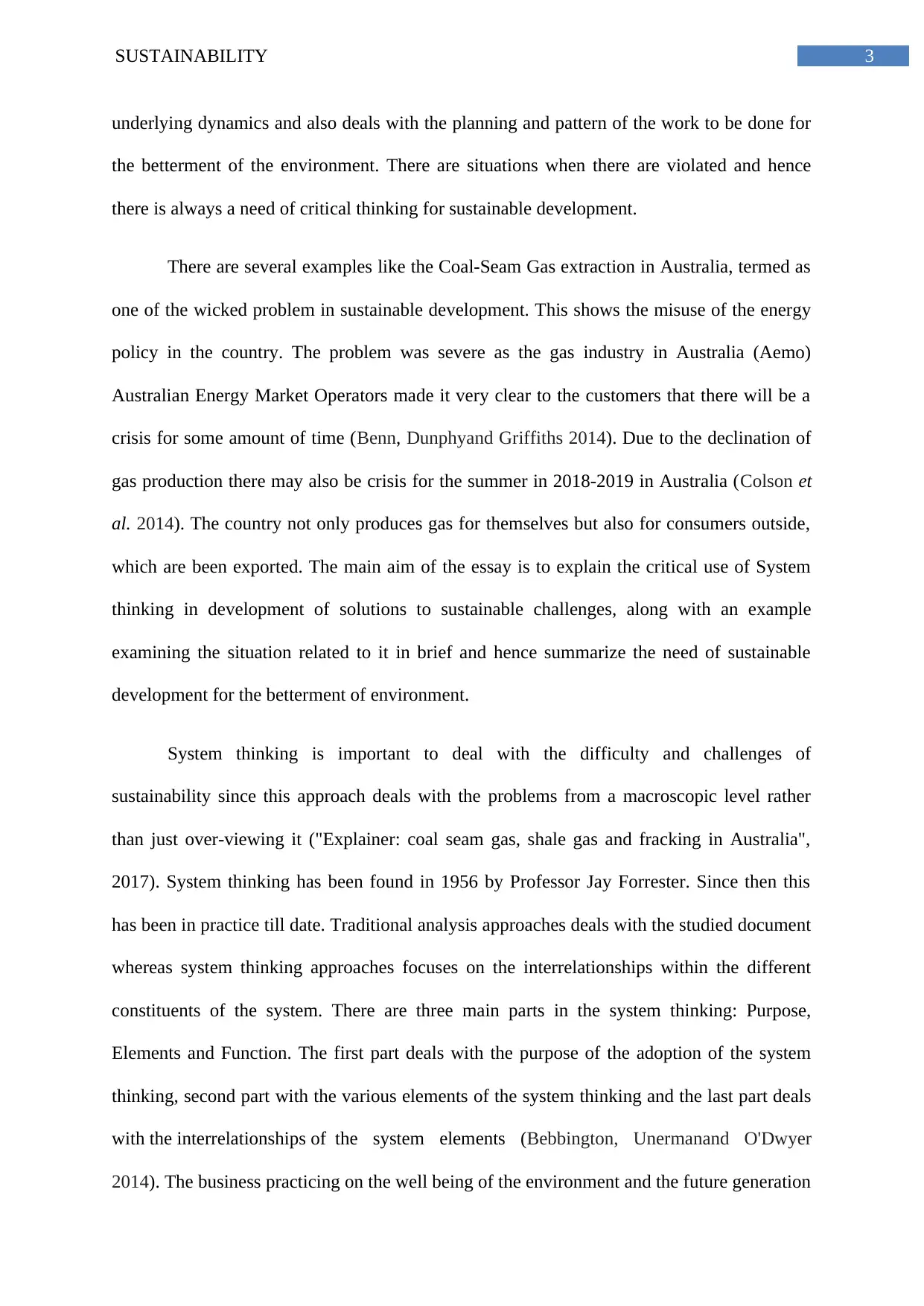
3SUSTAINABILITY
underlying dynamics and also deals with the planning and pattern of the work to be done for
the betterment of the environment. There are situations when there are violated and hence
there is always a need of critical thinking for sustainable development.
There are several examples like the Coal-Seam Gas extraction in Australia, termed as
one of the wicked problem in sustainable development. This shows the misuse of the energy
policy in the country. The problem was severe as the gas industry in Australia (Aemo)
Australian Energy Market Operators made it very clear to the customers that there will be a
crisis for some amount of time (Benn, Dunphyand Griffiths 2014). Due to the declination of
gas production there may also be crisis for the summer in 2018-2019 in Australia (Colson et
al. 2014). The country not only produces gas for themselves but also for consumers outside,
which are been exported. The main aim of the essay is to explain the critical use of System
thinking in development of solutions to sustainable challenges, along with an example
examining the situation related to it in brief and hence summarize the need of sustainable
development for the betterment of environment.
System thinking is important to deal with the difficulty and challenges of
sustainability since this approach deals with the problems from a macroscopic level rather
than just over-viewing it ("Explainer: coal seam gas, shale gas and fracking in Australia",
2017). System thinking has been found in 1956 by Professor Jay Forrester. Since then this
has been in practice till date. Traditional analysis approaches deals with the studied document
whereas system thinking approaches focuses on the interrelationships within the different
constituents of the system. There are three main parts in the system thinking: Purpose,
Elements and Function. The first part deals with the purpose of the adoption of the system
thinking, second part with the various elements of the system thinking and the last part deals
with the interrelationships of the system elements (Bebbington, Unermanand O'Dwyer
2014). The business practicing on the well being of the environment and the future generation
underlying dynamics and also deals with the planning and pattern of the work to be done for
the betterment of the environment. There are situations when there are violated and hence
there is always a need of critical thinking for sustainable development.
There are several examples like the Coal-Seam Gas extraction in Australia, termed as
one of the wicked problem in sustainable development. This shows the misuse of the energy
policy in the country. The problem was severe as the gas industry in Australia (Aemo)
Australian Energy Market Operators made it very clear to the customers that there will be a
crisis for some amount of time (Benn, Dunphyand Griffiths 2014). Due to the declination of
gas production there may also be crisis for the summer in 2018-2019 in Australia (Colson et
al. 2014). The country not only produces gas for themselves but also for consumers outside,
which are been exported. The main aim of the essay is to explain the critical use of System
thinking in development of solutions to sustainable challenges, along with an example
examining the situation related to it in brief and hence summarize the need of sustainable
development for the betterment of environment.
System thinking is important to deal with the difficulty and challenges of
sustainability since this approach deals with the problems from a macroscopic level rather
than just over-viewing it ("Explainer: coal seam gas, shale gas and fracking in Australia",
2017). System thinking has been found in 1956 by Professor Jay Forrester. Since then this
has been in practice till date. Traditional analysis approaches deals with the studied document
whereas system thinking approaches focuses on the interrelationships within the different
constituents of the system. There are three main parts in the system thinking: Purpose,
Elements and Function. The first part deals with the purpose of the adoption of the system
thinking, second part with the various elements of the system thinking and the last part deals
with the interrelationships of the system elements (Bebbington, Unermanand O'Dwyer
2014). The business practicing on the well being of the environment and the future generation
Secure Best Marks with AI Grader
Need help grading? Try our AI Grader for instant feedback on your assignments.
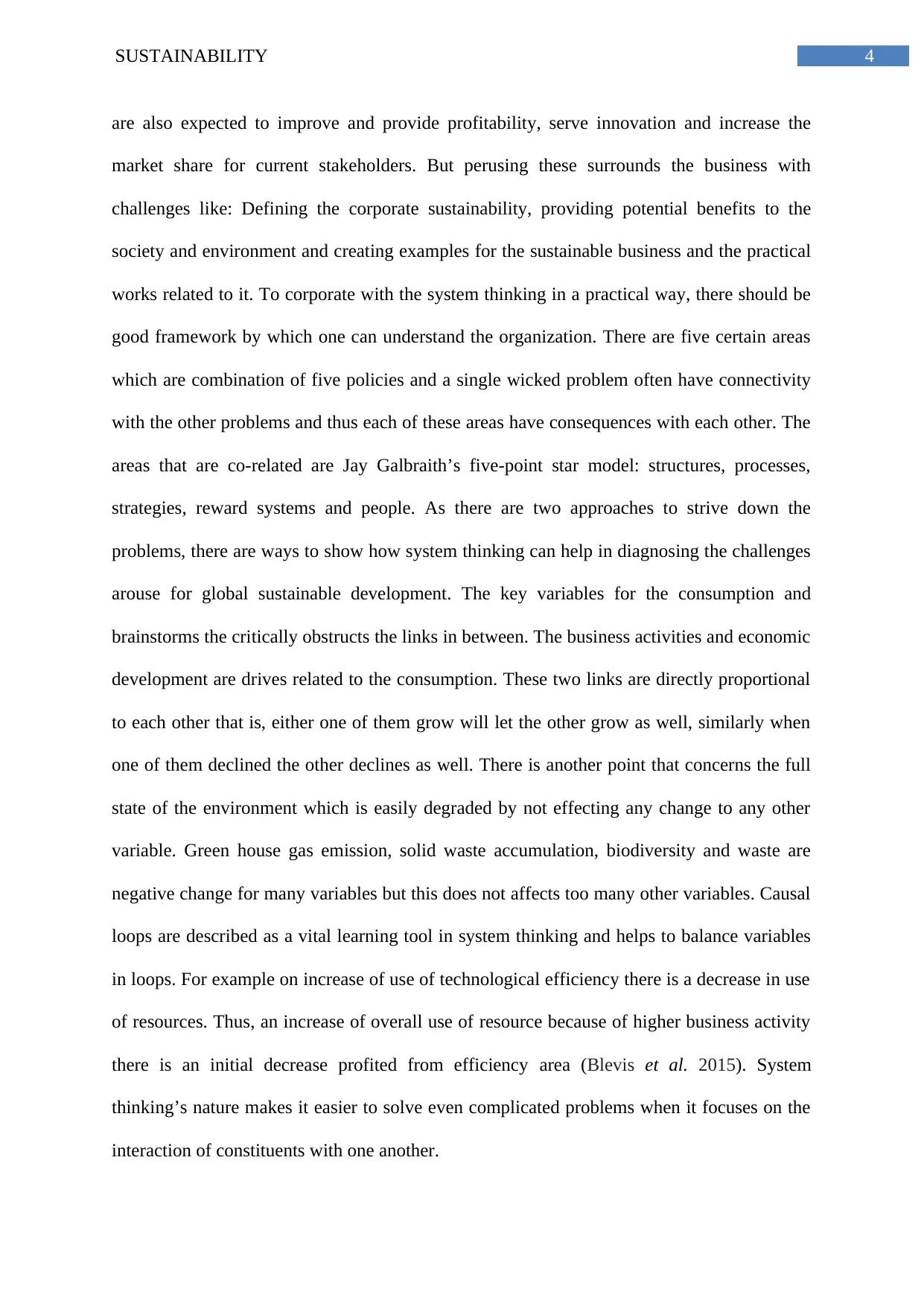
4SUSTAINABILITY
are also expected to improve and provide profitability, serve innovation and increase the
market share for current stakeholders. But perusing these surrounds the business with
challenges like: Defining the corporate sustainability, providing potential benefits to the
society and environment and creating examples for the sustainable business and the practical
works related to it. To corporate with the system thinking in a practical way, there should be
good framework by which one can understand the organization. There are five certain areas
which are combination of five policies and a single wicked problem often have connectivity
with the other problems and thus each of these areas have consequences with each other. The
areas that are co-related are Jay Galbraith’s five-point star model: structures, processes,
strategies, reward systems and people. As there are two approaches to strive down the
problems, there are ways to show how system thinking can help in diagnosing the challenges
arouse for global sustainable development. The key variables for the consumption and
brainstorms the critically obstructs the links in between. The business activities and economic
development are drives related to the consumption. These two links are directly proportional
to each other that is, either one of them grow will let the other grow as well, similarly when
one of them declined the other declines as well. There is another point that concerns the full
state of the environment which is easily degraded by not effecting any change to any other
variable. Green house gas emission, solid waste accumulation, biodiversity and waste are
negative change for many variables but this does not affects too many other variables. Causal
loops are described as a vital learning tool in system thinking and helps to balance variables
in loops. For example on increase of use of technological efficiency there is a decrease in use
of resources. Thus, an increase of overall use of resource because of higher business activity
there is an initial decrease profited from efficiency area (Blevis et al. 2015). System
thinking’s nature makes it easier to solve even complicated problems when it focuses on the
interaction of constituents with one another.
are also expected to improve and provide profitability, serve innovation and increase the
market share for current stakeholders. But perusing these surrounds the business with
challenges like: Defining the corporate sustainability, providing potential benefits to the
society and environment and creating examples for the sustainable business and the practical
works related to it. To corporate with the system thinking in a practical way, there should be
good framework by which one can understand the organization. There are five certain areas
which are combination of five policies and a single wicked problem often have connectivity
with the other problems and thus each of these areas have consequences with each other. The
areas that are co-related are Jay Galbraith’s five-point star model: structures, processes,
strategies, reward systems and people. As there are two approaches to strive down the
problems, there are ways to show how system thinking can help in diagnosing the challenges
arouse for global sustainable development. The key variables for the consumption and
brainstorms the critically obstructs the links in between. The business activities and economic
development are drives related to the consumption. These two links are directly proportional
to each other that is, either one of them grow will let the other grow as well, similarly when
one of them declined the other declines as well. There is another point that concerns the full
state of the environment which is easily degraded by not effecting any change to any other
variable. Green house gas emission, solid waste accumulation, biodiversity and waste are
negative change for many variables but this does not affects too many other variables. Causal
loops are described as a vital learning tool in system thinking and helps to balance variables
in loops. For example on increase of use of technological efficiency there is a decrease in use
of resources. Thus, an increase of overall use of resource because of higher business activity
there is an initial decrease profited from efficiency area (Blevis et al. 2015). System
thinking’s nature makes it easier to solve even complicated problems when it focuses on the
interaction of constituents with one another.
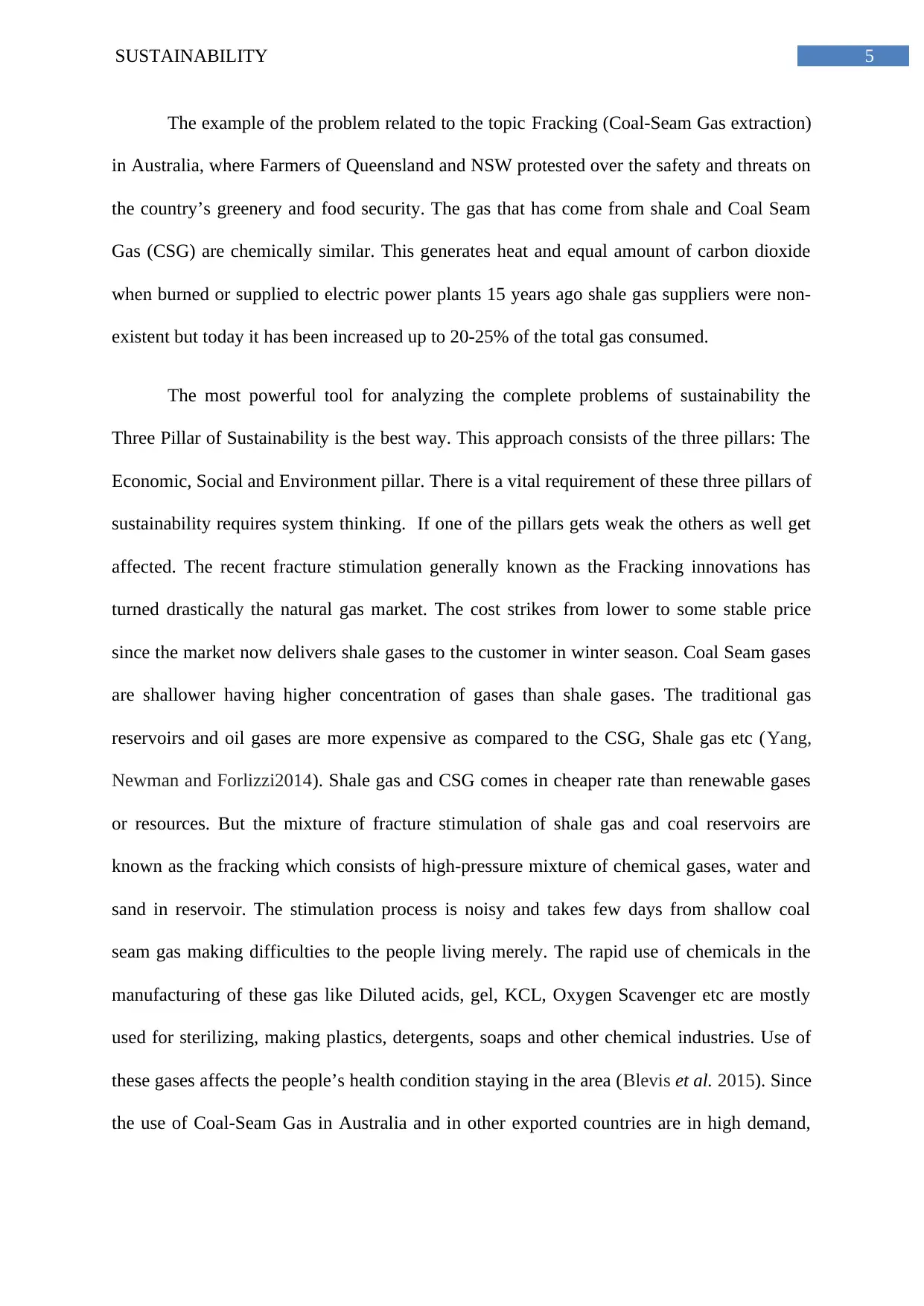
5SUSTAINABILITY
The example of the problem related to the topic Fracking (Coal-Seam Gas extraction)
in Australia, where Farmers of Queensland and NSW protested over the safety and threats on
the country’s greenery and food security. The gas that has come from shale and Coal Seam
Gas (CSG) are chemically similar. This generates heat and equal amount of carbon dioxide
when burned or supplied to electric power plants 15 years ago shale gas suppliers were non-
existent but today it has been increased up to 20-25% of the total gas consumed.
The most powerful tool for analyzing the complete problems of sustainability the
Three Pillar of Sustainability is the best way. This approach consists of the three pillars: The
Economic, Social and Environment pillar. There is a vital requirement of these three pillars of
sustainability requires system thinking. If one of the pillars gets weak the others as well get
affected. The recent fracture stimulation generally known as the Fracking innovations has
turned drastically the natural gas market. The cost strikes from lower to some stable price
since the market now delivers shale gases to the customer in winter season. Coal Seam gases
are shallower having higher concentration of gases than shale gases. The traditional gas
reservoirs and oil gases are more expensive as compared to the CSG, Shale gas etc (Yang,
Newman and Forlizzi2014). Shale gas and CSG comes in cheaper rate than renewable gases
or resources. But the mixture of fracture stimulation of shale gas and coal reservoirs are
known as the fracking which consists of high-pressure mixture of chemical gases, water and
sand in reservoir. The stimulation process is noisy and takes few days from shallow coal
seam gas making difficulties to the people living merely. The rapid use of chemicals in the
manufacturing of these gas like Diluted acids, gel, KCL, Oxygen Scavenger etc are mostly
used for sterilizing, making plastics, detergents, soaps and other chemical industries. Use of
these gases affects the people’s health condition staying in the area (Blevis et al. 2015). Since
the use of Coal-Seam Gas in Australia and in other exported countries are in high demand,
The example of the problem related to the topic Fracking (Coal-Seam Gas extraction)
in Australia, where Farmers of Queensland and NSW protested over the safety and threats on
the country’s greenery and food security. The gas that has come from shale and Coal Seam
Gas (CSG) are chemically similar. This generates heat and equal amount of carbon dioxide
when burned or supplied to electric power plants 15 years ago shale gas suppliers were non-
existent but today it has been increased up to 20-25% of the total gas consumed.
The most powerful tool for analyzing the complete problems of sustainability the
Three Pillar of Sustainability is the best way. This approach consists of the three pillars: The
Economic, Social and Environment pillar. There is a vital requirement of these three pillars of
sustainability requires system thinking. If one of the pillars gets weak the others as well get
affected. The recent fracture stimulation generally known as the Fracking innovations has
turned drastically the natural gas market. The cost strikes from lower to some stable price
since the market now delivers shale gases to the customer in winter season. Coal Seam gases
are shallower having higher concentration of gases than shale gases. The traditional gas
reservoirs and oil gases are more expensive as compared to the CSG, Shale gas etc (Yang,
Newman and Forlizzi2014). Shale gas and CSG comes in cheaper rate than renewable gases
or resources. But the mixture of fracture stimulation of shale gas and coal reservoirs are
known as the fracking which consists of high-pressure mixture of chemical gases, water and
sand in reservoir. The stimulation process is noisy and takes few days from shallow coal
seam gas making difficulties to the people living merely. The rapid use of chemicals in the
manufacturing of these gas like Diluted acids, gel, KCL, Oxygen Scavenger etc are mostly
used for sterilizing, making plastics, detergents, soaps and other chemical industries. Use of
these gases affects the people’s health condition staying in the area (Blevis et al. 2015). Since
the use of Coal-Seam Gas in Australia and in other exported countries are in high demand,
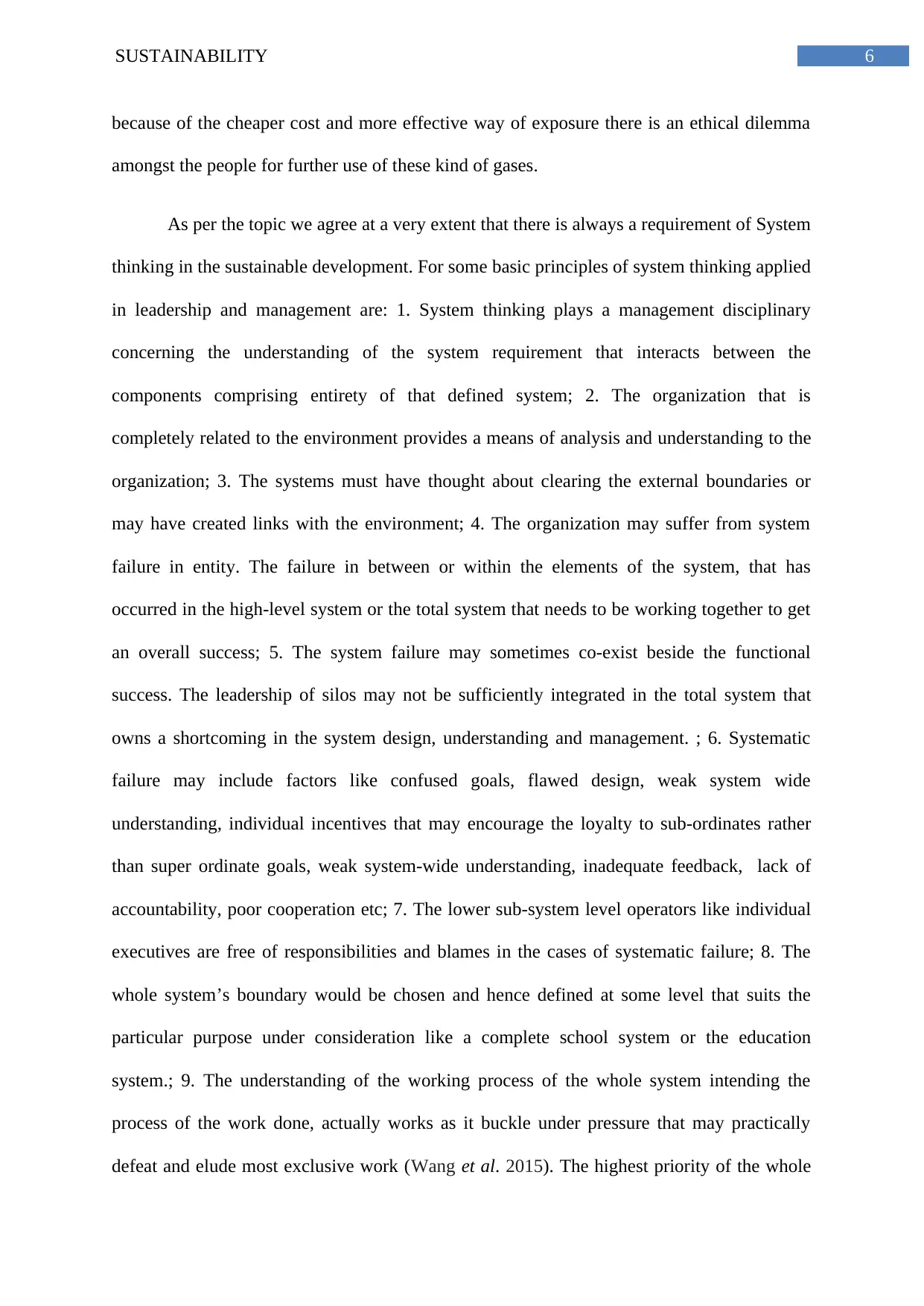
6SUSTAINABILITY
because of the cheaper cost and more effective way of exposure there is an ethical dilemma
amongst the people for further use of these kind of gases.
As per the topic we agree at a very extent that there is always a requirement of System
thinking in the sustainable development. For some basic principles of system thinking applied
in leadership and management are: 1. System thinking plays a management disciplinary
concerning the understanding of the system requirement that interacts between the
components comprising entirety of that defined system; 2. The organization that is
completely related to the environment provides a means of analysis and understanding to the
organization; 3. The systems must have thought about clearing the external boundaries or
may have created links with the environment; 4. The organization may suffer from system
failure in entity. The failure in between or within the elements of the system, that has
occurred in the high-level system or the total system that needs to be working together to get
an overall success; 5. The system failure may sometimes co-exist beside the functional
success. The leadership of silos may not be sufficiently integrated in the total system that
owns a shortcoming in the system design, understanding and management. ; 6. Systematic
failure may include factors like confused goals, flawed design, weak system wide
understanding, individual incentives that may encourage the loyalty to sub-ordinates rather
than super ordinate goals, weak system-wide understanding, inadequate feedback, lack of
accountability, poor cooperation etc; 7. The lower sub-system level operators like individual
executives are free of responsibilities and blames in the cases of systematic failure; 8. The
whole system’s boundary would be chosen and hence defined at some level that suits the
particular purpose under consideration like a complete school system or the education
system.; 9. The understanding of the working process of the whole system intending the
process of the work done, actually works as it buckle under pressure that may practically
defeat and elude most exclusive work (Wang et al. 2015). The highest priority of the whole
because of the cheaper cost and more effective way of exposure there is an ethical dilemma
amongst the people for further use of these kind of gases.
As per the topic we agree at a very extent that there is always a requirement of System
thinking in the sustainable development. For some basic principles of system thinking applied
in leadership and management are: 1. System thinking plays a management disciplinary
concerning the understanding of the system requirement that interacts between the
components comprising entirety of that defined system; 2. The organization that is
completely related to the environment provides a means of analysis and understanding to the
organization; 3. The systems must have thought about clearing the external boundaries or
may have created links with the environment; 4. The organization may suffer from system
failure in entity. The failure in between or within the elements of the system, that has
occurred in the high-level system or the total system that needs to be working together to get
an overall success; 5. The system failure may sometimes co-exist beside the functional
success. The leadership of silos may not be sufficiently integrated in the total system that
owns a shortcoming in the system design, understanding and management. ; 6. Systematic
failure may include factors like confused goals, flawed design, weak system wide
understanding, individual incentives that may encourage the loyalty to sub-ordinates rather
than super ordinate goals, weak system-wide understanding, inadequate feedback, lack of
accountability, poor cooperation etc; 7. The lower sub-system level operators like individual
executives are free of responsibilities and blames in the cases of systematic failure; 8. The
whole system’s boundary would be chosen and hence defined at some level that suits the
particular purpose under consideration like a complete school system or the education
system.; 9. The understanding of the working process of the whole system intending the
process of the work done, actually works as it buckle under pressure that may practically
defeat and elude most exclusive work (Wang et al. 2015). The highest priority of the whole
Paraphrase This Document
Need a fresh take? Get an instant paraphrase of this document with our AI Paraphraser
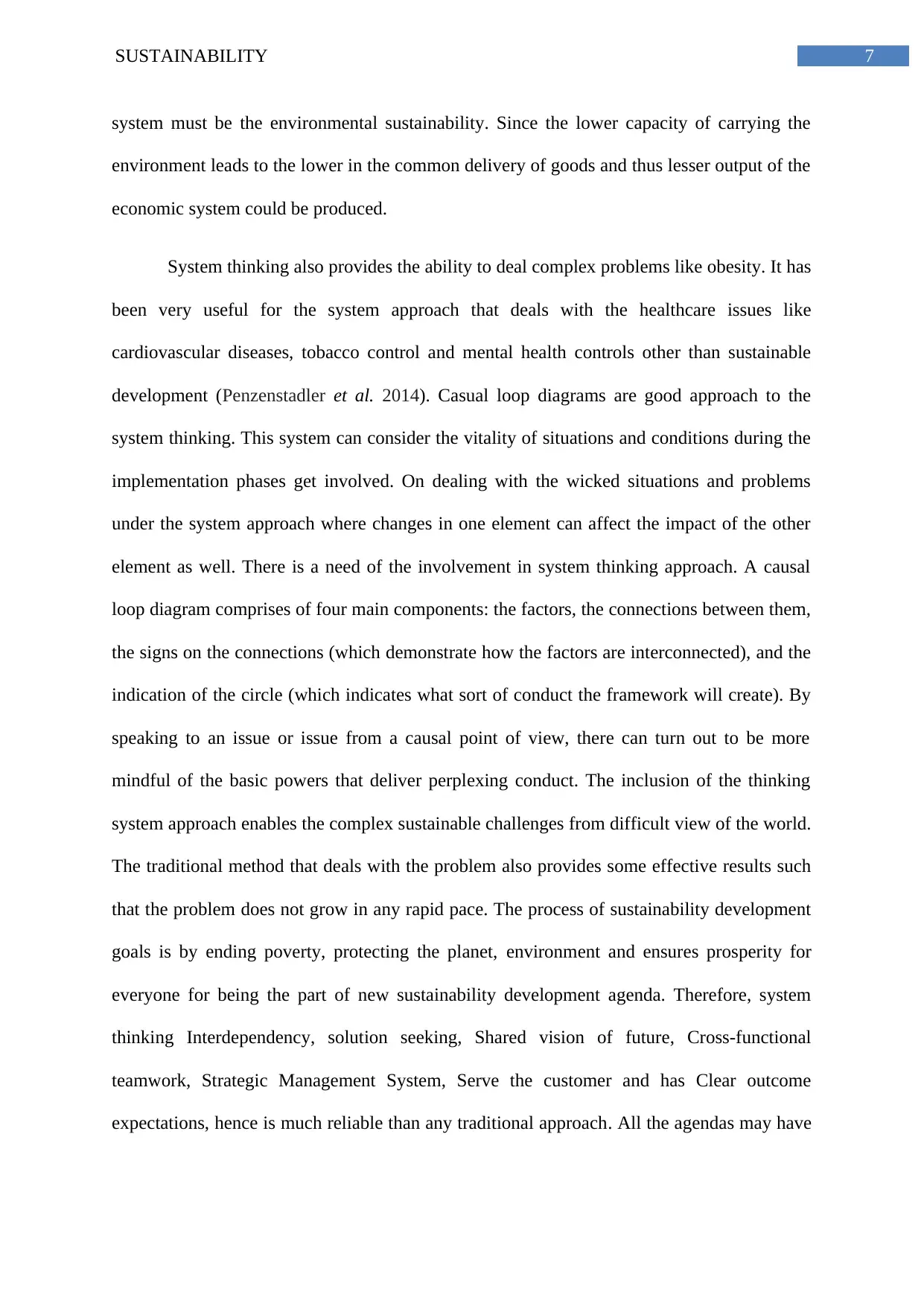
7SUSTAINABILITY
system must be the environmental sustainability. Since the lower capacity of carrying the
environment leads to the lower in the common delivery of goods and thus lesser output of the
economic system could be produced.
System thinking also provides the ability to deal complex problems like obesity. It has
been very useful for the system approach that deals with the healthcare issues like
cardiovascular diseases, tobacco control and mental health controls other than sustainable
development (Penzenstadler et al. 2014). Casual loop diagrams are good approach to the
system thinking. This system can consider the vitality of situations and conditions during the
implementation phases get involved. On dealing with the wicked situations and problems
under the system approach where changes in one element can affect the impact of the other
element as well. There is a need of the involvement in system thinking approach. A causal
loop diagram comprises of four main components: the factors, the connections between them,
the signs on the connections (which demonstrate how the factors are interconnected), and the
indication of the circle (which indicates what sort of conduct the framework will create). By
speaking to an issue or issue from a causal point of view, there can turn out to be more
mindful of the basic powers that deliver perplexing conduct. The inclusion of the thinking
system approach enables the complex sustainable challenges from difficult view of the world.
The traditional method that deals with the problem also provides some effective results such
that the problem does not grow in any rapid pace. The process of sustainability development
goals is by ending poverty, protecting the planet, environment and ensures prosperity for
everyone for being the part of new sustainability development agenda. Therefore, system
thinking Interdependency, solution seeking, Shared vision of future, Cross-functional
teamwork, Strategic Management System, Serve the customer and has Clear outcome
expectations, hence is much reliable than any traditional approach. All the agendas may have
system must be the environmental sustainability. Since the lower capacity of carrying the
environment leads to the lower in the common delivery of goods and thus lesser output of the
economic system could be produced.
System thinking also provides the ability to deal complex problems like obesity. It has
been very useful for the system approach that deals with the healthcare issues like
cardiovascular diseases, tobacco control and mental health controls other than sustainable
development (Penzenstadler et al. 2014). Casual loop diagrams are good approach to the
system thinking. This system can consider the vitality of situations and conditions during the
implementation phases get involved. On dealing with the wicked situations and problems
under the system approach where changes in one element can affect the impact of the other
element as well. There is a need of the involvement in system thinking approach. A causal
loop diagram comprises of four main components: the factors, the connections between them,
the signs on the connections (which demonstrate how the factors are interconnected), and the
indication of the circle (which indicates what sort of conduct the framework will create). By
speaking to an issue or issue from a causal point of view, there can turn out to be more
mindful of the basic powers that deliver perplexing conduct. The inclusion of the thinking
system approach enables the complex sustainable challenges from difficult view of the world.
The traditional method that deals with the problem also provides some effective results such
that the problem does not grow in any rapid pace. The process of sustainability development
goals is by ending poverty, protecting the planet, environment and ensures prosperity for
everyone for being the part of new sustainability development agenda. Therefore, system
thinking Interdependency, solution seeking, Shared vision of future, Cross-functional
teamwork, Strategic Management System, Serve the customer and has Clear outcome
expectations, hence is much reliable than any traditional approach. All the agendas may have
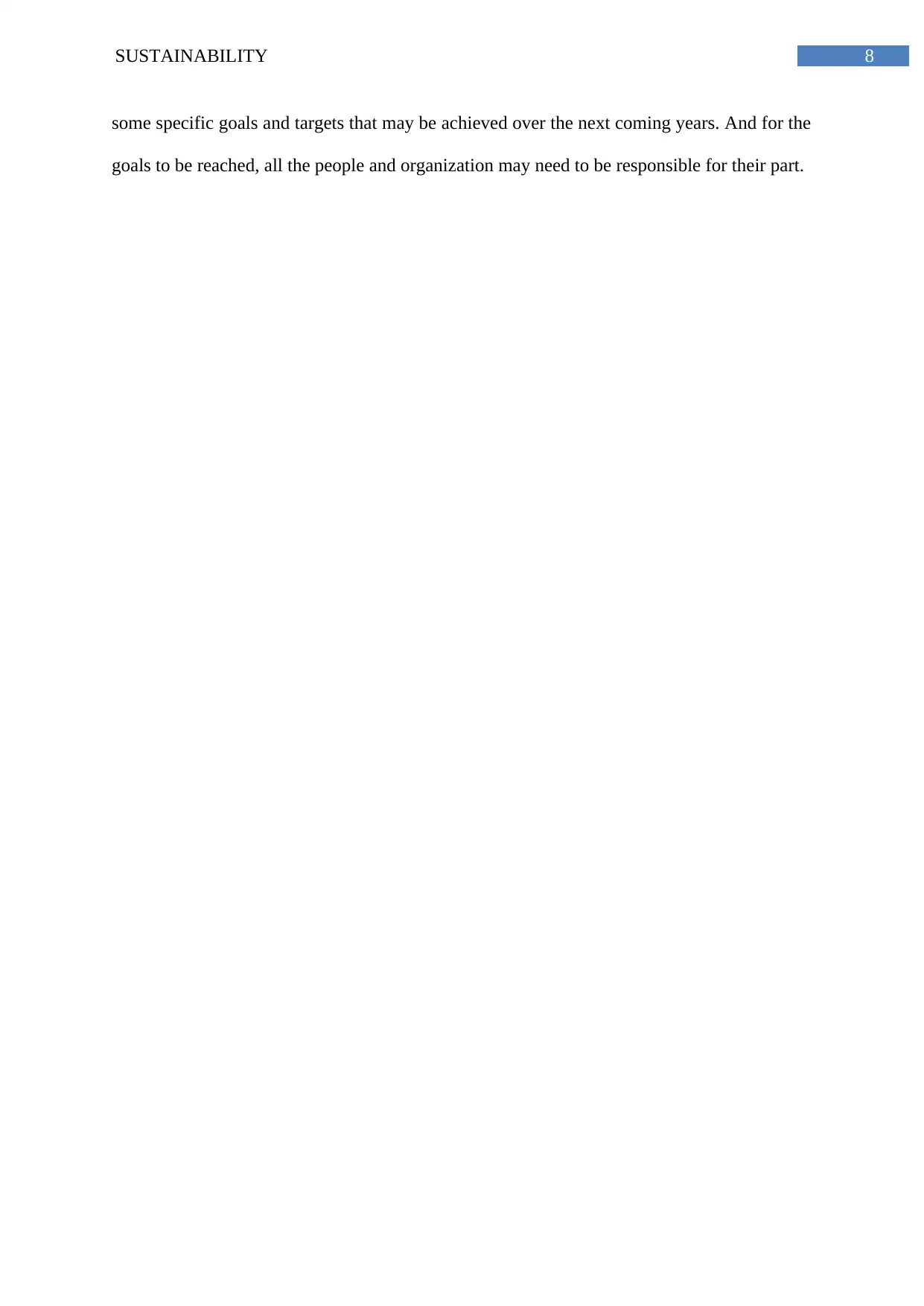
8SUSTAINABILITY
some specific goals and targets that may be achieved over the next coming years. And for the
goals to be reached, all the people and organization may need to be responsible for their part.
some specific goals and targets that may be achieved over the next coming years. And for the
goals to be reached, all the people and organization may need to be responsible for their part.
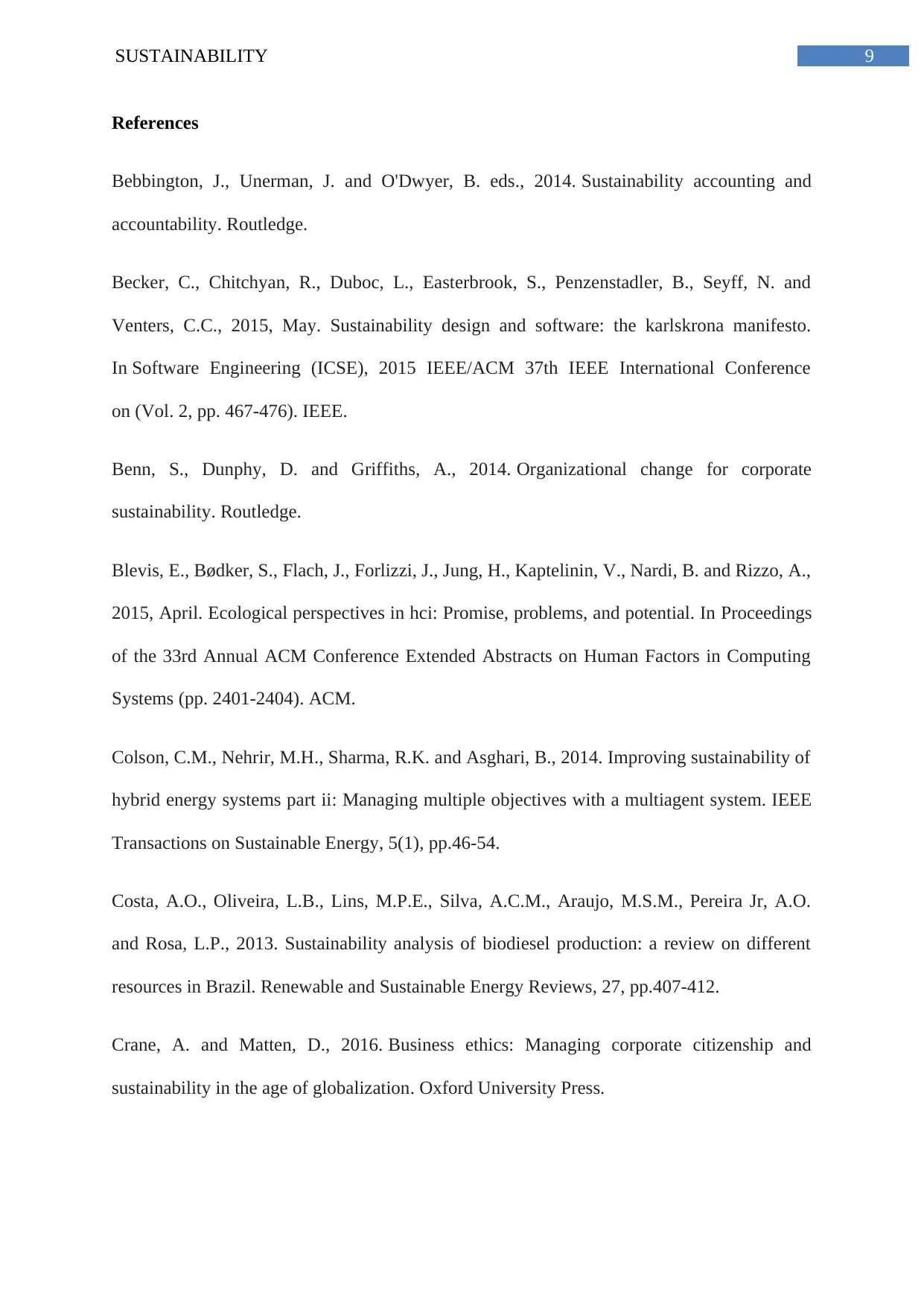
9SUSTAINABILITY
References
Bebbington, J., Unerman, J. and O'Dwyer, B. eds., 2014. Sustainability accounting and
accountability. Routledge.
Becker, C., Chitchyan, R., Duboc, L., Easterbrook, S., Penzenstadler, B., Seyff, N. and
Venters, C.C., 2015, May. Sustainability design and software: the karlskrona manifesto.
In Software Engineering (ICSE), 2015 IEEE/ACM 37th IEEE International Conference
on (Vol. 2, pp. 467-476). IEEE.
Benn, S., Dunphy, D. and Griffiths, A., 2014. Organizational change for corporate
sustainability. Routledge.
Blevis, E., Bødker, S., Flach, J., Forlizzi, J., Jung, H., Kaptelinin, V., Nardi, B. and Rizzo, A.,
2015, April. Ecological perspectives in hci: Promise, problems, and potential. In Proceedings
of the 33rd Annual ACM Conference Extended Abstracts on Human Factors in Computing
Systems (pp. 2401-2404). ACM.
Colson, C.M., Nehrir, M.H., Sharma, R.K. and Asghari, B., 2014. Improving sustainability of
hybrid energy systems part ii: Managing multiple objectives with a multiagent system. IEEE
Transactions on Sustainable Energy, 5(1), pp.46-54.
Costa, A.O., Oliveira, L.B., Lins, M.P.E., Silva, A.C.M., Araujo, M.S.M., Pereira Jr, A.O.
and Rosa, L.P., 2013. Sustainability analysis of biodiesel production: a review on different
resources in Brazil. Renewable and Sustainable Energy Reviews, 27, pp.407-412.
Crane, A. and Matten, D., 2016. Business ethics: Managing corporate citizenship and
sustainability in the age of globalization. Oxford University Press.
References
Bebbington, J., Unerman, J. and O'Dwyer, B. eds., 2014. Sustainability accounting and
accountability. Routledge.
Becker, C., Chitchyan, R., Duboc, L., Easterbrook, S., Penzenstadler, B., Seyff, N. and
Venters, C.C., 2015, May. Sustainability design and software: the karlskrona manifesto.
In Software Engineering (ICSE), 2015 IEEE/ACM 37th IEEE International Conference
on (Vol. 2, pp. 467-476). IEEE.
Benn, S., Dunphy, D. and Griffiths, A., 2014. Organizational change for corporate
sustainability. Routledge.
Blevis, E., Bødker, S., Flach, J., Forlizzi, J., Jung, H., Kaptelinin, V., Nardi, B. and Rizzo, A.,
2015, April. Ecological perspectives in hci: Promise, problems, and potential. In Proceedings
of the 33rd Annual ACM Conference Extended Abstracts on Human Factors in Computing
Systems (pp. 2401-2404). ACM.
Colson, C.M., Nehrir, M.H., Sharma, R.K. and Asghari, B., 2014. Improving sustainability of
hybrid energy systems part ii: Managing multiple objectives with a multiagent system. IEEE
Transactions on Sustainable Energy, 5(1), pp.46-54.
Costa, A.O., Oliveira, L.B., Lins, M.P.E., Silva, A.C.M., Araujo, M.S.M., Pereira Jr, A.O.
and Rosa, L.P., 2013. Sustainability analysis of biodiesel production: a review on different
resources in Brazil. Renewable and Sustainable Energy Reviews, 27, pp.407-412.
Crane, A. and Matten, D., 2016. Business ethics: Managing corporate citizenship and
sustainability in the age of globalization. Oxford University Press.
Secure Best Marks with AI Grader
Need help grading? Try our AI Grader for instant feedback on your assignments.
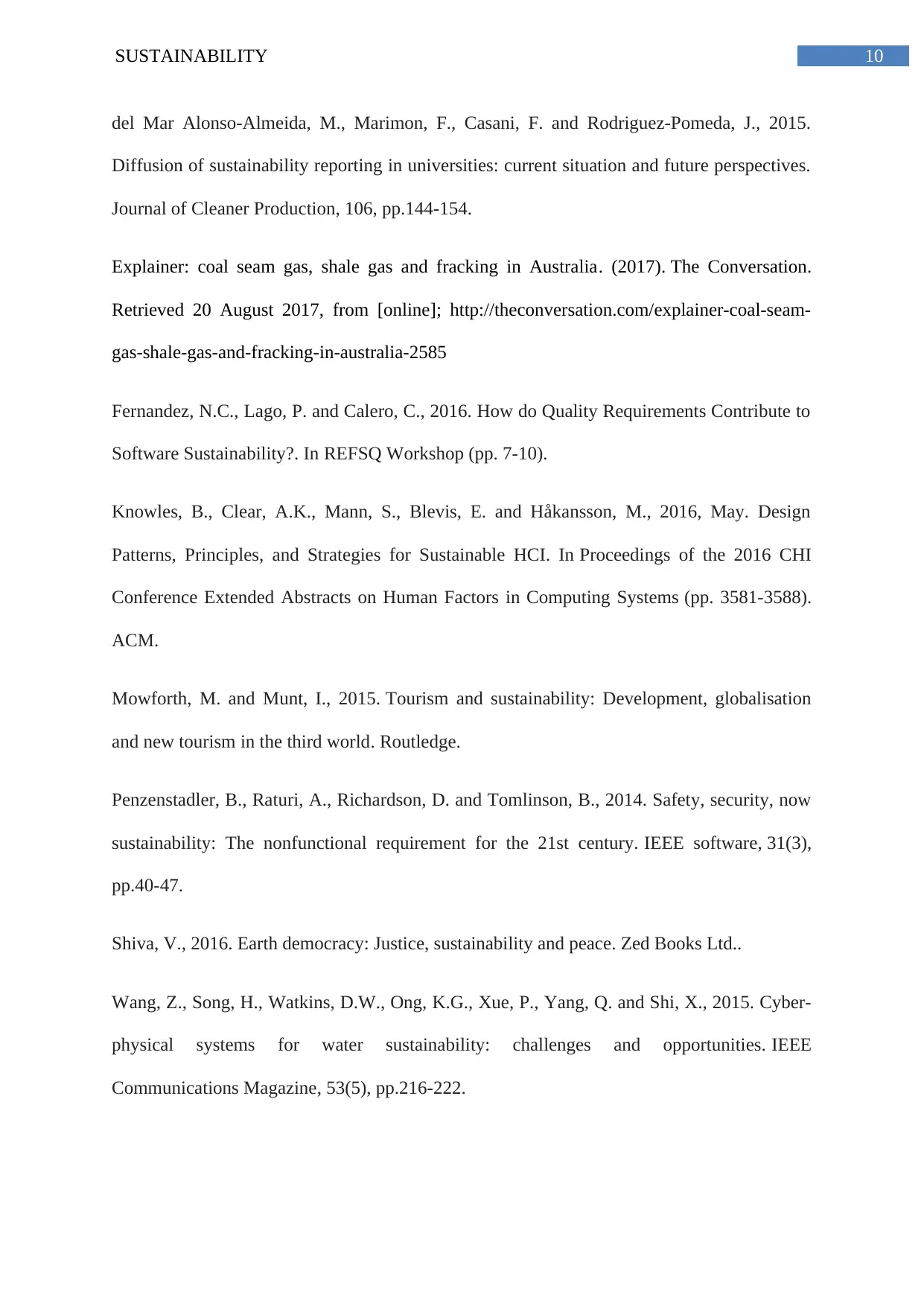
10SUSTAINABILITY
del Mar Alonso-Almeida, M., Marimon, F., Casani, F. and Rodriguez-Pomeda, J., 2015.
Diffusion of sustainability reporting in universities: current situation and future perspectives.
Journal of Cleaner Production, 106, pp.144-154.
Explainer: coal seam gas, shale gas and fracking in Australia. (2017). The Conversation.
Retrieved 20 August 2017, from [online]; http://theconversation.com/explainer-coal-seam-
gas-shale-gas-and-fracking-in-australia-2585
Fernandez, N.C., Lago, P. and Calero, C., 2016. How do Quality Requirements Contribute to
Software Sustainability?. In REFSQ Workshop (pp. 7-10).
Knowles, B., Clear, A.K., Mann, S., Blevis, E. and Håkansson, M., 2016, May. Design
Patterns, Principles, and Strategies for Sustainable HCI. In Proceedings of the 2016 CHI
Conference Extended Abstracts on Human Factors in Computing Systems (pp. 3581-3588).
ACM.
Mowforth, M. and Munt, I., 2015. Tourism and sustainability: Development, globalisation
and new tourism in the third world. Routledge.
Penzenstadler, B., Raturi, A., Richardson, D. and Tomlinson, B., 2014. Safety, security, now
sustainability: The nonfunctional requirement for the 21st century. IEEE software, 31(3),
pp.40-47.
Shiva, V., 2016. Earth democracy: Justice, sustainability and peace. Zed Books Ltd..
Wang, Z., Song, H., Watkins, D.W., Ong, K.G., Xue, P., Yang, Q. and Shi, X., 2015. Cyber-
physical systems for water sustainability: challenges and opportunities. IEEE
Communications Magazine, 53(5), pp.216-222.
del Mar Alonso-Almeida, M., Marimon, F., Casani, F. and Rodriguez-Pomeda, J., 2015.
Diffusion of sustainability reporting in universities: current situation and future perspectives.
Journal of Cleaner Production, 106, pp.144-154.
Explainer: coal seam gas, shale gas and fracking in Australia. (2017). The Conversation.
Retrieved 20 August 2017, from [online]; http://theconversation.com/explainer-coal-seam-
gas-shale-gas-and-fracking-in-australia-2585
Fernandez, N.C., Lago, P. and Calero, C., 2016. How do Quality Requirements Contribute to
Software Sustainability?. In REFSQ Workshop (pp. 7-10).
Knowles, B., Clear, A.K., Mann, S., Blevis, E. and Håkansson, M., 2016, May. Design
Patterns, Principles, and Strategies for Sustainable HCI. In Proceedings of the 2016 CHI
Conference Extended Abstracts on Human Factors in Computing Systems (pp. 3581-3588).
ACM.
Mowforth, M. and Munt, I., 2015. Tourism and sustainability: Development, globalisation
and new tourism in the third world. Routledge.
Penzenstadler, B., Raturi, A., Richardson, D. and Tomlinson, B., 2014. Safety, security, now
sustainability: The nonfunctional requirement for the 21st century. IEEE software, 31(3),
pp.40-47.
Shiva, V., 2016. Earth democracy: Justice, sustainability and peace. Zed Books Ltd..
Wang, Z., Song, H., Watkins, D.W., Ong, K.G., Xue, P., Yang, Q. and Shi, X., 2015. Cyber-
physical systems for water sustainability: challenges and opportunities. IEEE
Communications Magazine, 53(5), pp.216-222.
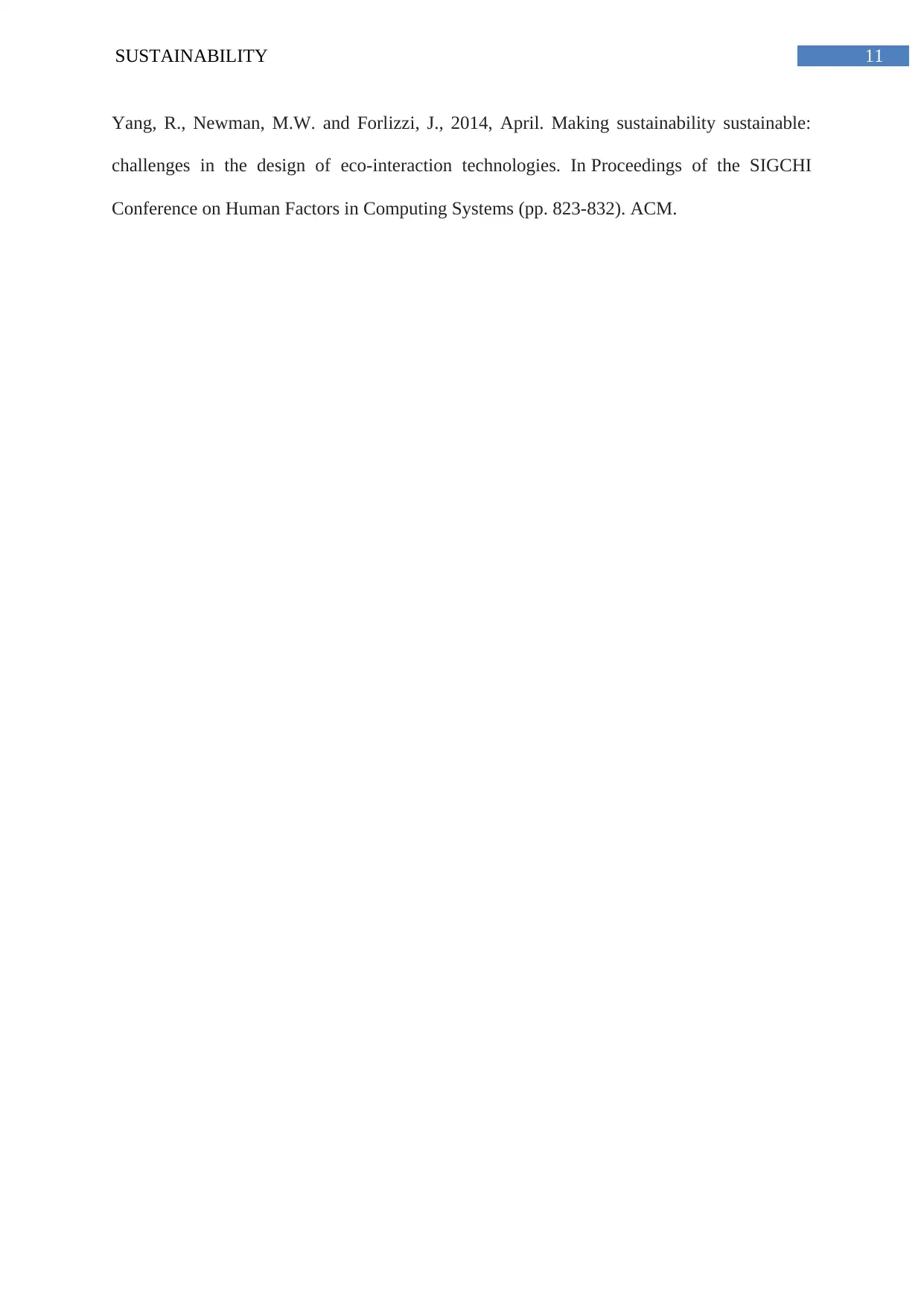
11SUSTAINABILITY
Yang, R., Newman, M.W. and Forlizzi, J., 2014, April. Making sustainability sustainable:
challenges in the design of eco-interaction technologies. In Proceedings of the SIGCHI
Conference on Human Factors in Computing Systems (pp. 823-832). ACM.
Yang, R., Newman, M.W. and Forlizzi, J., 2014, April. Making sustainability sustainable:
challenges in the design of eco-interaction technologies. In Proceedings of the SIGCHI
Conference on Human Factors in Computing Systems (pp. 823-832). ACM.
1 out of 12
Related Documents
Your All-in-One AI-Powered Toolkit for Academic Success.
+13062052269
info@desklib.com
Available 24*7 on WhatsApp / Email
![[object Object]](/_next/static/media/star-bottom.7253800d.svg)
Unlock your academic potential
© 2024 | Zucol Services PVT LTD | All rights reserved.





